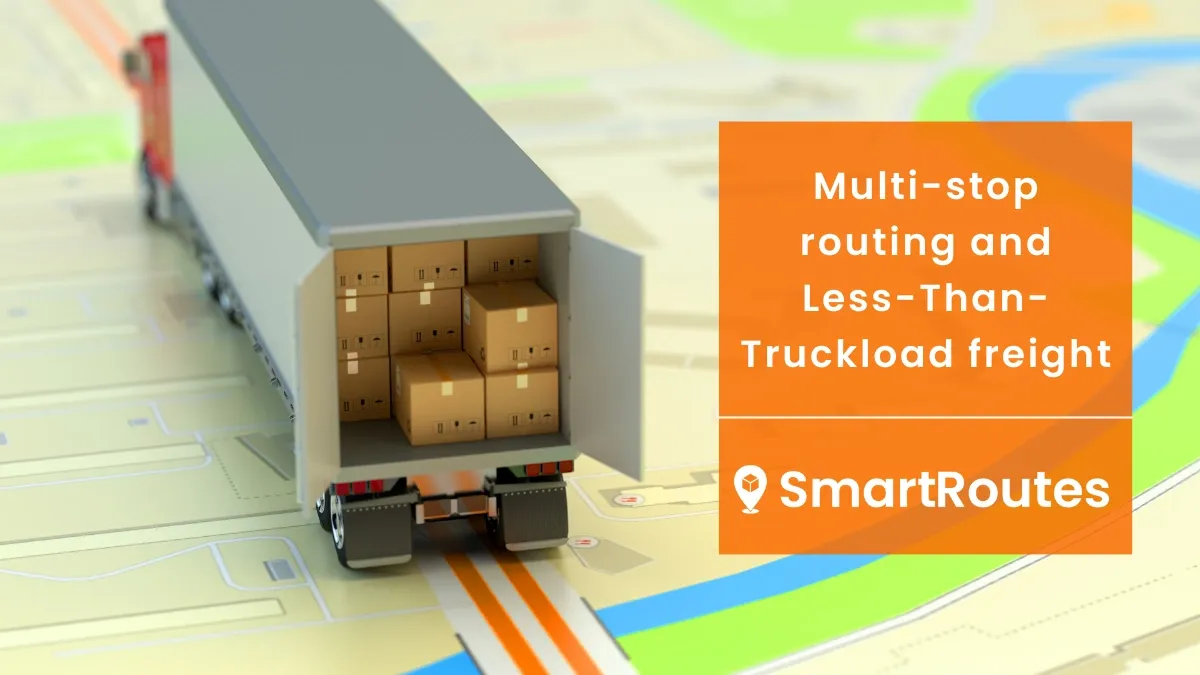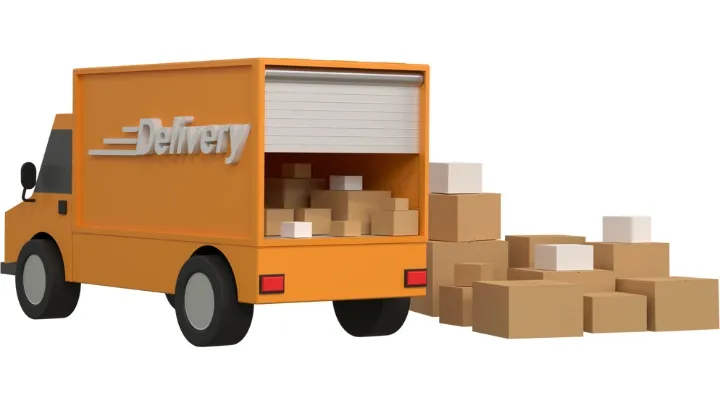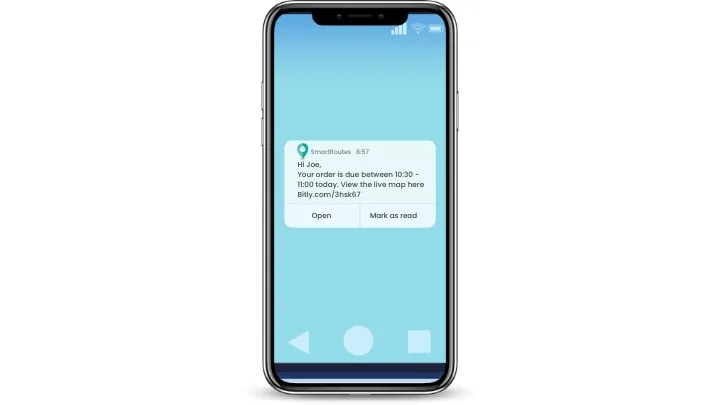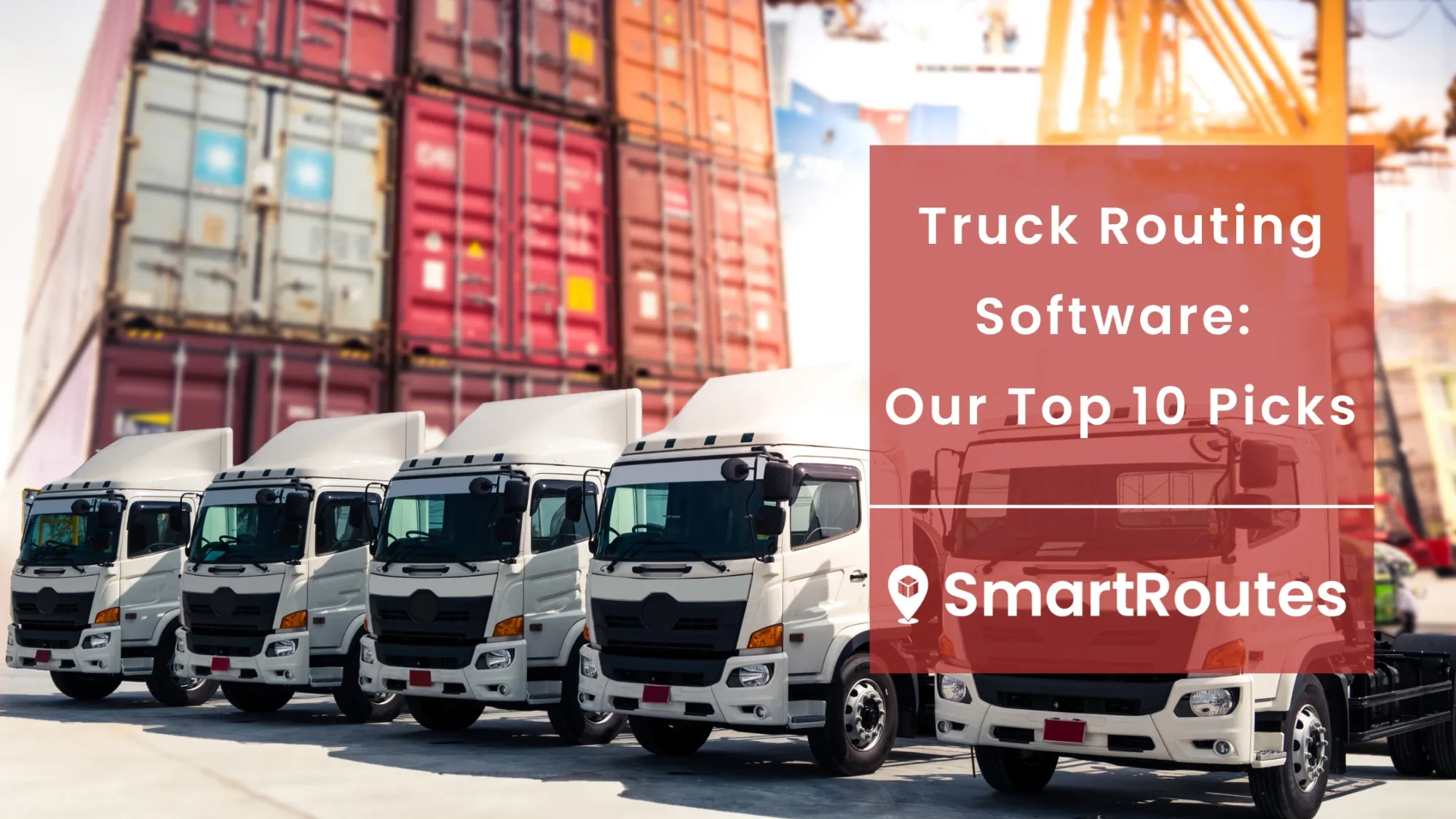How Multi Stop Routing Solutions can help LTL (Less-Than-Truckload) Freight
Discover how multi-stop routing solutions can optimize your LTL freight operations, improve efficiency, reduce costs and increase visibility.

Shipping Less-Than-Truckload (LTL) freight can be a complex and challenging process for businesses of all sizes. With multiple shipments to coordinate, varying freight classes and rates and the need to balance cost and efficiency, it can be difficult to manage LTL shipping effectively. However, with the help of dispatch and routing software, businesses can optimize their LTL freight arrangements and enjoy a range of benefits, including improved efficiency, reduced costs and better customer service.
In this blog, we will explore the benefits of using dispatch and routing software for LTL freight shipping and how it can help businesses of all sizes optimize their logistics operations.
What is less than truckload (LTL)?
How does LTL shipping differ from other shipping options?
What are the benefits of using LTL?
Factors to Consider When Shipping LTL
How multi-stop routing solutions can help Less-Than-Truckload freight
What is Less than Truckload (LTL)?
Transporting goods efficiently and cost-effectively is a critical aspect of any business that deals with shipping products. This is where Less than Truckload (LTL) shipping comes into play. LTL is a type of shipping service that is designed to transport small to medium-sized goods that do not require a full truckload. LTL carriers consolidate multiple shipments from different customers into a single truck, reducing transportation costs for each individual shipper.
LTL shipments typically weigh between 150 and 15,000 pounds, which is too large to be shipped via small package carriers like UPS or FedEx, but too small to require a full truckload. By using a hub-and-spoke system, LTL carriers can efficiently transport goods across a wide geographic area. Shipments are collected at local terminals, transported to a central hub and then redistributed to the appropriate terminal for final delivery.
How does LTL Shipping differ from other Shipping Options?
LTL shipping is an ideal option for businesses that need to ship freight that is too large to be shipped as a small parcel, but not large enough to fill an entire truckload., LTL shipments are a perfect solution for businesses that need to ship smaller quantities of goods.
One of the significant advantages of LTL shipping is its cost-effectiveness. LTL carriers consolidate multiple shipments from different customers into a single truck, which reduces transportation costs for each individual shipper. This means that LTL shipping is often more affordable than other shipping options, such as full truckload shipping or air freight.
Although LTL shipping can have longer transit times than other shipping options, many LTL carriers offer expedited shipping options to help minimize transit times. Transit times may be longer as shipments need to be consolidated and transported through a hub-and-spoke network of terminals.
When it comes to packaging, LTL shipments typically require more packaging than small parcel shipments, as they are more likely to be handled multiple times during transport. It is crucial to ensure that goods are packaged securely and appropriately to prevent damage during shipping.
One of the key advantages of LTL shipping is the tracking and tracing capabilities offered by LTL carriers. As shipments are handled multiple times, they can be difficult to locate without a comprehensive tracking system. Therefore, LTL carriers typically offer more robust tracking and tracing capabilities than other shipping options.
SmartRoutes Route Planning Software
Streamline your entire delivery process, all from one platform

What are the Benefits of using LTL?
Cost-Effective: LTL shipping is often more cost-effective than other shipping options, especially for businesses that need to ship smaller quantities of goods. It allows companies to save money on shipping costs while still getting their goods delivered in a timely and reliable manner.
Customizable: LTL shipping is also highly customizable, allowing businesses to tailor their shipping options to their specific needs. This includes choosing the level of service they need, such as expedited or standard shipping, and selecting the carrier that best fits their requirements.
Efficient: LTL carriers use a hub-and-spoke system, which allows them to efficiently transport goods across a wide geographic area. This can be especially important in last mile delivery, where goods need to be delivered quickly and efficiently to customers in densely populated urban areas.
Flexibility: LTL shipping also provides businesses with more flexibility in terms of scheduling and delivery options. Many carriers offer delivery windows or appointment-based delivery, allowing businesses to plan their shipments more effectively and maximise the opportunity to deliver on time.
How LTL Shipping Works
If you're new to LTL shipping, it can be helpful to understand how it operates. Here's a breakdown of how LTL shipping works:
- Collection of Shipments: LTL shipments are collected at local terminals and consolidated with other shipments from different customers. This allows LTL carriers to reduce transportation costs for each individual shipper.
- Transportation to Central Hub: Once the shipments are collected, they are transported to a central hub where they are sorted and consolidated onto larger trucks for further transportation.
- Redistribution to Appropriate Terminal: After reaching the central hub, the shipments are redistributed to the appropriate terminal for final delivery.
LTL carriers use advanced technology to track shipments as they move through the network, optimizing routes and ensuring timely delivery. This technology also allows for real-time tracking and tracing of shipments, providing greater visibility into the shipping process for both shippers and carriers.

LTL shipping also allows you to efficiently transport goods across a wide geographic area. This is possible because LTL carriers can leverage their network of terminals to reach remote locations that may not be served by other shipping options. This is particularly beneficial for businesses that need to transport goods to customers in densely populated urban areas or remote regions.
Factors to Consider When Shipping LTL
While LTL shipping can be a cost-effective and efficient option for transporting small to medium-sized shipments, there are several factors to consider when choosing an LTL carrier.
The first factor to consider is freight size and weight. LTL shipping is designed for freight that is too large to be shipped as a small parcel, but not large enough to require a full truckload. LTL carriers typically handle shipments that weigh between 150 and 15,000 pounds. It is important to ensure that your shipment falls within these weight limits to avoid any additional fees or delays.
Another important consideration is packaging. LTL shipments often require more packaging than small parcel shipments, as they are more likely to be handled multiple times during transport. This means that shippers need to ensure that their goods are packaged securely and appropriately to prevent damage during shipping. It's also important to follow carrier guidelines for packaging and labeling to avoid any issues with delivery.
Transit times are another important factor to keep in mind when choosing an LTL carrier. LTL shipping can have longer transit times than other shipping options, as shipments need to be consolidated and transported through a hub-and-spoke network of terminals. It's important to consider transit times when choosing an LTL carrier, especially if you have specific delivery deadlines to meet. Many LTL carriers offer expedited shipping options to help minimize transit times.
Finally, tracking and tracing capabilities are essential when it comes to LTL shipping. LTL carriers typically offer more robust tracking and tracing capabilities than other shipping options, as shipments are handled multiple times and can be difficult to locate without a comprehensive tracking system. It's important to choose an LTL carrier that offers real-time tracking and tracing of shipments, as this provides greater visibility into the shipping process and can help identify and resolve any issues that may arise during transit.
How Multi Stop Routing Solutions can help Less-Than-Truckload Freight
Optimized Routes
Multi-stop routing solutions allows LTL carriers to optimize their routes and ensure that each shipment is transported in the most efficient way possible. It provides businesses with more flexibility in terms of scheduling and delivery options. Many carriers offer delivery windows or appointment-based delivery, allowing businesses to plan their shipments more effectively and minimize the risk of delays or missed deliveries.
In addition to reducing transit times, optimized routing can also lower fuel costs for LTL carriers. By creating the most efficient route possible, carriers can minimize the distance traveled and reduce the amount of fuel needed to transport their shipments. By using route planning software to plan the most efficient route, carriers can better plan for unexpected delays or road closures, ensuring that shipments arrive on time and in the correct order. They also ensure that LTL carriers assign the correct number of trucks and drivers to each shipment, further improving delivery accuracy.
Better Capacity Utilization
Traditionally, LTL carriers operate on a hub-and-spoke system, which means that shipments are collected at local terminals and then transported to a central hub. From there, the shipments are consolidated onto larger trucks and transported to the appropriate terminal for final delivery. However, even with this system, carriers often struggle to fill their trucks to capacity, which can lead to wasted space and higher costs.
By using multi-stop routing solutions, carriers can consolidate multiple LTL shipments that are going in the same direction into a single truckload. This not only helps to better utilize the available capacity but also results in reduced handling and loading time at the terminal. Additionally, carriers can maximize their revenue per mile by transporting more freight with fewer trucks. This is especially important for smaller carriers who may not have the resources to invest in a large fleet of trucks.

Real-Time Visibility
Real-time visibility is a critical component of successful LTL shipping and multi-stop routing solutions provide this capability by offering real-time tracking and tracing of shipments. With this technology, carriers can monitor the location and status of their shipments at all times, providing them with up-to-date information about the progress of their deliveries. This visibility can also benefit shippers, who can receive timely updates on the status of their shipments and plan for any necessary adjustments.
Real-time visibility allows carriers to identify potential issues and take corrective action before they become major problems. For example, if a shipment is delayed due to traffic or weather conditions, carriers can use real-time tracking to identify the delay and adjust their route or delivery schedule accordingly. This can help prevent further delays and ensure that the shipment arrives on time.
Improved Customer Service
Improved customer service is another significant benefit of multi-stop routing solutions for LTL carriers. With the help of optimized routing and real-time visibility, carriers can provide more accurate delivery estimates to their customers, which can improve customer satisfaction and build trust. Additionally, real-time tracking information enables shippers to monitor their shipments and know exactly when they will arrive, which can help them plan their operations more effectively.

Furthermore, multi-stop routing solutions can help carriers provide better communication and transparency to their customers. By keeping customers informed about their shipments with notifications throughout the delivery process, carriers can build stronger relationships with them and improve their overall experience. This can lead to repeat business and positive reviews, which can be a significant advantage in a competitive marketplace.
Reducing Costs
Multi-stop routing solutions can also help LTL carriers reduce costs in other ways. For example, real-time visibility into shipments can help carriers identify potential issues or delays and take corrective action before they become more costly problems. This can include rerouting shipments, adjusting delivery schedules or addressing any issues with the shipment itself.
Multi-stop routing solutions can also help carriers reduce costs associated with administrative tasks such as manual order entry, routing and scheduling. With automated tools that streamline these processes, carriers can save time and reduce errors, which can lead to more efficient operations and lower costs. Another way that multi-stop routing solutions can reduce costs is by enabling carriers to negotiate better rates with shippers. By demonstrating their ability to optimize routes and consolidate shipments, carriers can offer more competitive pricing and win more business. This can lead to increased revenue and profitability for carriers over time.
Improving Efficiency
In addition to reducing costs, multi-stop routing solutions can also improve the overall efficiency of LTL shipping. Real-time visibility into the shipping process can help carriers identify potential bottlenecks and take corrective action before they become larger issues. Furthermore, multi-stop routing solutions can help streamline the overall shipping process by providing carriers with tools to automate tasks such as scheduling, dispatching and tracking. This can help reduce the amount of time and effort required to manage LTL shipments, freeing up resources to focus on other aspects of the business.
Looking for logistics software to improve your LTL shipping operations?
Multi-stop routing solutions can provide numerous benefits for LTL carriers and shippers, including optimized routes, better capacity utilization, real-time visibility, improved customer service, reduced costs, and improved efficiency. Logistics software such as SmartRoutes can help carriers take advantage of these benefits by providing advanced dispatch and routing features. If you're interested in experiencing the benefits of logistics software for LTL shipping firsthand, you can take advantage of SmartRoutes 7 day free trial or book a demo to see how routing software can improve your LTL freight operations.
Frequently asked questions
1. What is Less-Than-Truckload (LTL) freight, and how does it differ from other shipping options?
Less-Than-Truckload (LTL) freight is a shipping method designed for relatively small shipments that don't require a full truck for transportation. Unlike Full Truckload (FTL) shipping, where an entire truck is dedicated to a single shipment, LTL freight combines multiple smaller shipments from different senders into a single truck, sharing the transportation costs.
2. How can multi-stop routing solutions optimize LTL freight deliveries?
Multi-stop routing solutions optimize LTL freight deliveries by efficiently planning routes that minimize transit times, reduce fuel consumption, and lower overall transportation costs. These solutions use advanced algorithms to determine the most cost-effective and time-efficient route for a driver, considering multiple stops along the way.
3. What factors should shippers consider when choosing a multi-stop routing solution for LTL freight?
Shippers should consider factors such as scalability, real-time tracking capabilities, integration with existing systems, cost-effectiveness, and the provider's reputation and reliability. Scalability ensures the solution can handle a growing volume of shipments, while real-time tracking allows shippers and customers to monitor shipment progress.
If you liked this blog you might also be interested in:








